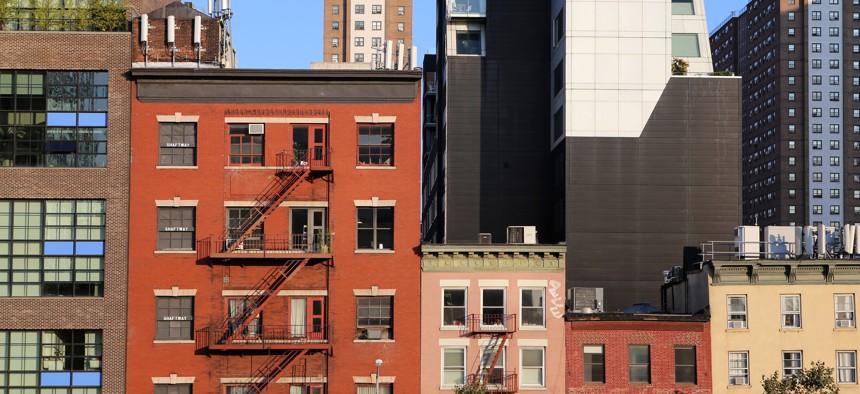5 things to know about Eric Adams’ latest housing proposal

Eric Adams’ housing proposals include eliminating parking requirements and allowing accessory units. Busà Photography, Moment/Getty Images
The New York City mayor unveiled the latest on his goal to become a “City of Yes.”
New York City Mayor Eric Adams unveiled a massive overhaul on how the city approaches development Thursday, proclaiming that the proposed reforms could pave the way for as many as 100,000 new homes over the next 15 years.
The proposals, which center on reforming long-standing zoning regulations and cutting red tape in every single neighborhood, come as the city contends with a dire, ever-worsening housing shortage. Various rules that have long limited growth have complicated the city’s ability to build enough low-cost housing to accommodate everyone in the city—a shortage that has become all the more extreme with the arrival of more than 110,000 migrants since spring 2022. Adams’ proposals range from allowing conversions of empty houses, allowing more accessory dwelling units, ending rules requiring parking to be built into housing, and more. It’s the third and most expansive package related to housing that he’s announced in recent months.
“This is not tinkering around the edges, this is groundbreaking, literally,” Adams said of the proposals.
While unveiling his plan at Borough of Manhattan Community College Thursday, Adams described the “City of Yes for Housing Opportunity” proposal as having the potential to enact the most transformative change since the 1961 zoning code—a code rife with outdated exclusionary policies, according to Adams.
“It is long past time that we dismantled zoning rules written by people that could not even fathom a Black mayor, a Black speaker and a majority-woman City Council,” Deputy Mayor Maria Torres-Springer said Thursday.
Here are five things to know about the mayor’s sweeping new plan
Ending Parking Mandates
One proposal included in Adams' plan is to eliminate mandates that require parking to be built alongside new homes. These mandates, which largely apply to projects outside of Manhattan, have long gobbled up space that could be used for more housing while also driving up construction costs, adding around $67,500 per underground parking space, according to City Hall.
While the proposal wouldn’t prevent parking from being included with new developments, it would remove the costly requirement. As Adams said in his speech, it just makes sense—especially given that fewer than half of the city’s residents own cars.
"Everyday New Yorkers are hurt by the city’s prioritization of driving above all else. We can’t have the environment, the housing, or the economic growth we need to thrive as long as outdated parking mandates stay in place,” Sara Lind, co-executive director at pro-housing group Open Plans, said in a statement. “With this leadership from DCP and Mayor Adams, New York City can finally begin to rectify the harms done by a zoning code that encourages driving but makes it more difficult to actually get where we’re going.”
Allowing Accessory Dwellings
Another policy would legalize additional dwelling units up to 800 square feet within one- and two-bedroom family properties. That could mean anything from backyard cottages, to garage conversions and basement units. Adams said these types of units, which have been long sought by pro-development advocates, would go a long way in meeting families' needs. They would enable seniors to stay in their neighborhoods and young couples a place to live while they build up their careers and income.
More Places to Build
Adams’ plan would also allow apartments to be built in areas where housing is currently barred or restricted such as over bodegas, restaurants and other commercial buildings operating on commercial strips. Other proposals would also overturn current zoning that bars similar types of apartment buildings from being built near some subway stations, and allow for housing to be built on public housing campuses and church parking lots.
Albany’s Part
New York City’s need for new housing development is no secret. Consensus has grown rapidly in recent years that the city needs to do everything that it possibly can to make space for more people. State lawmakers have done little to further the city’s housing goals with Gov. Kathy Hochul’s own sweeping plan rejected in the Legislature earlier this year amid suburban pushback. Adams emphasized Thursday that the raft of policies are actions the city can take on its own. Still, he said, the city needs the state’s help to solve its affordability crisis.
The Council Has the Final Say
While the introduction of the proposals marked a significant step, a long process lies ahead. The New York City Council will ultimately get final say in a vote as early as next fall, but as the proposals wind through the public review process, New Yorkers all across the city will get the chance to weigh in before each borough president and community board casts advisory votes. Even after implementation, the effects would take years to materialize
City Council Speaker Adrienne Adams said she welcomes Mayor Adams and City Planning’s “encouraging and thoughtful proposals” as a meaningful starting point toward enacting more equitable housing production.
“We look forward to conducting a thorough review of the proposals in these preliminary scoping documents and continuing discussions with the administration and all stakeholders throughout this process to successfully advance the city’s housing needs,” she said in a statement. “Delivering results for New Yorkers will require actions at the city level, along with essential contributions from our state and federal partners.”





